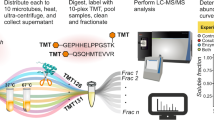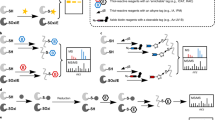Abstract
Metalloproteases are a large, diverse class of enzymes involved in many physiological and disease processes. Metalloproteases are regulated by post-translational mechanisms that diminish the effectiveness of conventional genomic and proteomic methods for their functional characterization. Chemical probes directed at active sites offer a potential way to measure metalloprotease activities in biological systems; however, large variations in structure limit the scope of any single small-molecule probe aimed at profiling this enzyme class. Here, we address this problem by creating a library of metalloprotease-directed probes that show complementary target selectivity. These probes were applied as a 'cocktail' to proteomes and their labeling profiles were analyzed collectively using an advanced liquid chromatography–mass spectrometry platform. More than 20 metalloproteases were identified, including members from nearly all of the major branches of this enzyme class. These findings suggest that chemical proteomic methods can serve as a universal strategy to profile the activity of the metalloprotease superfamily in complex biological systems.
This is a preview of subscription content, access via your institution
Access options
Subscribe to this journal
Receive 12 print issues and online access
$259.00 per year
only $21.58 per issue
Buy this article
- Purchase on Springer Link
- Instant access to full article PDF
Prices may be subject to local taxes which are calculated during checkout






Similar content being viewed by others
References
Gerlt, J.A. & Babbitt, P.C. Divergent evolution of enzymatic function: mechanistically diverse superfamilies and functionally distinct suprafamilies. Annu. Rev. Biochem. 70, 209–246 (2001).
Saghatelian, A. & Cravatt, B.F. Assignment of protein function in the postgenomic era. Nat. Chem. Biol. 1, 130–142 (2005).
Kobe, B. & Kemp, B.E. Active site-directed protein regulation. Nature 402, 373–376 (1999).
Liu, Y., Patricelli, M.P. & Cravatt, B.F. Activity-based protein profiling: the serine hydrolases. Proc. Natl. Acad. Sci. USA 96, 14694–14699 (1999).
Jessani, N. & Cravatt, B.F. The development and application of methods for activity-based protein profiling. Curr. Opin. Chem. Biol. 8, 54–59 (2004).
Speers, A.E. & Cravatt, B.F. Chemical strategies for activity-based proteomics. ChemBioChem 5, 41–47 (2004).
Kidd, D., Liu, Y. & Cravatt, B.F. Profiling serine hydrolase activities in complex proteomes. Biochemistry 40, 4005–4015 (2001).
Saghatelian, A., Jessani, N., Joseph, A., Humphrey, M. & Cravatt, B.F. Activity-based probes for the proteomic profiling of metalloproteases. Proc. Natl. Acad. Sci. USA 101, 10000–10005 (2004).
Jessani, N., Liu, Y., Humphrey, M. & Cravatt, B.F. Enzyme activity profiles of the secreted and membrane proteome that depict cancer invasiveness. Proc. Natl. Acad. Sci. USA 99, 10335–10340 (2002).
Greenbaum, D.C. et al. Small molecule affinity fingerprinting. A tool for enzyme family subclassification, target identification, and inhibitor design. Chem. Biol. 9, 1085–1094 (2002).
Jessani, N. et al. Carcinoma and stromal enzyme activity profiles associated with breast tumor growth in vivo. Proc. Natl. Acad. Sci. USA 101, 13756–13761 (2004).
Joyce, J.A. et al. Cathepsin cysteine proteases are effectors of invasive growth and angiogenesis during multistage tumorigenesis. Cancer Cell 5, 443–453 (2004).
Jessani, N. et al. A streamlined platform for high-content functional proteomics of primary human specimens. Nat. Methods 2, 691–697 (2005).
Greenbaum, D.C. et al. A role for the protease falcipain 1 in host cell invasion by the human malaria parasite. Science 298, 2002–2006 (2002).
Barglow, K.T. & Cravatt, B.F. Discovering disease-associated enzymes by proteome reactivity profiling. Chem. Biol. 11, 1523–1531 (2004).
Patricelli, M.P., Giang, D.K., Stamp, L.M. & Burbaum, J.J. Direct visualization of serine hydrolase activities in complex proteome using fluorescent active site-directed probes. Proteomics 1, 1067–1071 (2001).
Kato, D. et al. Activity-based probes that target diverse cysteine protease families. Nat. Chem. Biol. 1, 33–38 (2005).
Adam, G.C., Sorensen, E.J. & Cravatt, B.F. Proteomic profiling of mechanistically distinct enzyme classes using a common chemotype. Nat. Biotechnol. 20, 805–809 (2002).
Vocadlo, D.J. & Bertozzi, C.R. A strategy for functional proteomic analysis of glycosidase activity from cell lysates. Angew. Chem. Int. Edn. Engl. 43, 5338–5342 (2004).
Hekmat, O., Kim, Y.W., Williams, S.J., He, S. & Withers, S.G. Active-site peptide “fingerprinting” of glycosidases in complex mixtures by mass spectrometry. Discovery of a novel retaining beta-1,4-glycanase in Cellulomonas fimi. J. Biol. Chem. 280, 35126–35135 (2005).
Liu, Y. et al. Wortmannin, a widely used phosphoinositide 3-kinase inhibitor, also potently inhibits mammalian polo-like kinase. Chem. Biol. 12, 99–107 (2005).
Chan, E.W., Chattopadhaya, S., Panicker, R.C., Huang, X. & Yao, S.Q. Developing photoactive affinity probes for proteomic profiling: hydroxamate-based probes for metalloproteases. J. Am. Chem. Soc. 126, 14435–14446 (2004).
Puente, X.S., Sanchez, L.M., Overall, C.M. & Lopez-Otin, C. Human and mouse proteases: a comparative genomic approach. Nat. Rev. Genet. 4, 544–558 (2003).
Chang, C. & Werb, Z. The many faces of metalloproteases: cell growth, invasion, angiogenesis, and metastasis. Trends Cell Biol. 11, S37–S43 (2001).
Turner, A.J., Isaac, R.E. & Coates, D. The neprilysin (NEP) family of zinc metalloendopeptidases: genomics and function. Bioessays 23, 261–269 (2001).
Lynch, C.C. & Matrisian, L.M. Matrix metalloproteinases in tumor-host cell communication. Differentiation 70, 561–573 (2002).
Overall, C.M. & Lopez-Otin, C. Strategies for MMP inhibition in cancer: innovations for the post-trial era. Nat. Rev. Cancer 2, 657–672 (2002).
Johnson, W.H., Roberts, N.A. & Borkakoti, N. Collagenase inhibitors: their design and potential therapeutic use. J. Enzyme Inhib. 2, 1–22 (1987).
Stoermer, D. et al. Synthesis and biological evaluation of hydroxamate-based inhibitors of glutamate carboxypeptidase II. Bioorg. Med. Chem. Lett. 13, 2097–2100 (2003).
Jani, M., Tordai, H., Trexler, M., Banyai, L. & Patthy, L. Hydroxamate-based peptide inhibitors of matrix metalloprotease 2. Biochimie 87, 385–392 (2005).
Speers, A.E., Adam, G.C. & Cravatt, B.F. Activity-based protein profiling in vivo using a copper(I)-catalyzed azide-alkyne [3 + 2] cycloaddition. J. Am. Chem. Soc. 125, 4686–4687 (2003).
Speers, A.E. & Cravatt, B.F. Profiling enzyme activities in vivo using click chemistry methods. Chem. Biol. 11, 535–546 (2004).
Turk, B.E., Huang, L.L., Piro, E.T. & Cantley, L.C. Determination of protease cleavage site motifs using mixture-based oriented peptide libraries. Nat. Biotechnol. 19, 661–667 (2001).
Washburn, M.P., Wolters, D. & Yates, J.R., III. Large-scale analysis of the yeast proteome by multidimensional protein identification technology. Nat. Biotechnol. 19, 242–247 (2001).
Seftor, E.A. et al. Molecular determinants of human uveal melanoma invasion and metastasis. Clin. Exp. Metastasis 19, 233–246 (2002).
Moss, M.L. & Bartsch, J.W. Therapeutic benefits from targeting of ADAM family members. Biochemistry 43, 7227–7235 (2004).
Blobel, C.P. ADAMs: key components in EGFR signalling and development. Nat. Rev. Mol. Cell Biol. 6, 32–43 (2005).
Whittaker, M., Floyd, C.D., Brown, P. & Gearing, A.J. Design and therapeutic application of matrix metalloproteinase inhibitors. Chem. Rev. 99, 2735–2776 (1999).
Seftor, E.A. et al. Epigenetic transdifferentiation of normal melanocytes by a metastatic melanoma microenvironment. Cancer Res. 65, 10164–10169 (2005).
Ogata, Y., Itoh, Y. & Nagase, H. Steps involved in activation of the pro-matrix metalloproteinase 9 (progelatinase B)-tissue inhibitor of metalloproteinases-1 complex by 4-aminophenylmercuric acetate and proteinases. J. Biol. Chem. 270, 18506–18511 (1995).
Speers, A.E. & Cravatt, B.F. A tandem orthogonal proteolysis strategy for high-content chemical proteomics. J. Am. Chem. Soc. 127, 10018–10019 (2005).
Mock, W.L. & Cheng, H. Principles of hydroxamate inhibition of metalloproteases: carboxypeptidase A. Biochemistry 39, 13945–13952 (2000).
Rawlings, N.D., Tolle, D.P. & Barrett, A.J. MEROPS: the peptidase database. Nucleic Acids Res. 32, D160–D164 (2004).
Chenna, R. et al. Multiple sequence alignment with the Clustal series of programs. Nucleic Acids Res. 31, 3497–3500 (2003).
Saitou, N. & Nei, M. The neighbor-joining method: a new method for reconstructing phylogenetic trees. Mol. Biol. Evol. 4, 406–425 (1987).
Bingham, J. & Sudarsanam, S. Visualizing large hierarchical clusters in hyperbolic space. Bioinformatics 16, 660–661 (2000).
Acknowledgements
We thank G. Simon for assistance with construction of the metalloprotease family tree diagram, A. Saghatelian for assistance with probe synthesis, M. Madsen for assistance with cell culture, and S. Niessen and B. Wei for assistance with the analysis of MudPIT data. This work was supported by the US National Institutes of Health (CA087660), Activx Biosciences, the Skaggs Institute for Chemical Biology and a DFG Emmy Noether postdoctoral fellowship (S.A.S.).
Author information
Authors and Affiliations
Corresponding author
Ethics declarations
Competing interests
The authors declare no competing financial interests.
Supplementary information
Supplementary Fig. 1
Synthesis, structures and characterization of HxBPyne probe library. (PDF 491 kb)
Supplementary Fig. 2
Representative 1D gels showing the proteome reactivity profiles of members of the HxBPyne library. (PDF 177 kb)
Supplementary Fig. 3
Labeling of native and recombinant MPs by HxBPyne probes. (PDF 56 kb)
Supplementary Fig. 4
HxBPyne labeling of MMPs. (PDF 156 kb)
Supplementary Fig. 5
Expression levels of MPs in human melanoma cell lines. (PDF 59 kb)
Supplementary Fig. 6
Examples of MPs that were found at equivalent levels in HxBPyne-treated proteomes and control proteomes treated either with excess HxBPane probes or without any probe. (PDF 29 kb)
Supplementary Table 1
Complete list of specifically labeled MP targets identified by the optimal HxBPyne probe set and ABPP-MudPIT. (PDF 113 kb)
Rights and permissions
About this article
Cite this article
Sieber, S., Niessen, S., Hoover, H. et al. Proteomic profiling of metalloprotease activities with cocktails of active-site probes. Nat Chem Biol 2, 274–281 (2006). https://doi.org/10.1038/nchembio781
Received:
Accepted:
Published:
Issue Date:
DOI: https://doi.org/10.1038/nchembio781
This article is cited by
-
Substrate-biased activity-based probes identify proteases that cleave receptor CDCP1
Nature Chemical Biology (2021)
-
Caspase selective reagents for diagnosing apoptotic mechanisms
Cell Death & Differentiation (2019)
-
Proteomic approaches beyond expression profiling and PTM analysis
Analytical and Bioanalytical Chemistry (2018)
-
In situ click chemistry generation of cyclooxygenase-2 inhibitors
Nature Communications (2017)
-
Transition-Metal-Catalyzed Bioorthogonal Cycloaddition Reactions
Topics in Current Chemistry (2016)



